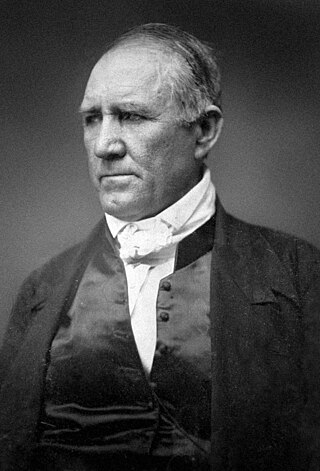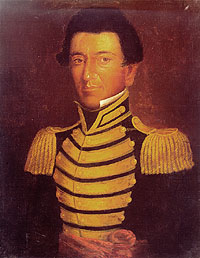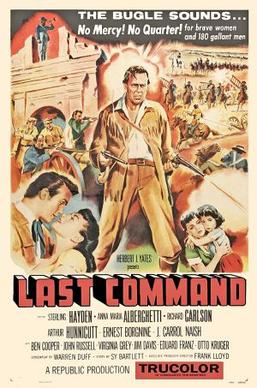
Samuel Houston was an American and Texan general and statesman who played an important role in the Texas Revolution. He served as the first and third president of the Republic of Texas and was one of the first two individuals to represent Texas in the United States Senate. He also served as the sixth governor of Tennessee and the seventh governor of Texas, the only individual to be elected governor of two different states in the United States.

Erastus "Deaf" Smith, who earned his nickname due to hearing loss in childhood, was an American frontiersman noted for his part in the Texas Revolution and the Army of the Republic of Texas. He fought in the Grass Fight and the Battle of San Jacinto. After the war, Deaf Smith led a company of Texas Rangers.

Juan Nepomuceno Seguín was a Spanish-Tejano political and military figure of the Texas Revolution who helped to establish the independence of Texas. Numerous places and institutions are named in his honor, including the county seat of Seguin in Guadalupe County, the Juan N. Seguin Memorial Interchange in Houston, Juan Seguin Monument in Seguin, World War II Liberty Ship SS Juan N. Seguin, Seguin High School in Arlington.

The Alamo is a 1960 American epic historical war film about the 1836 Battle of the Alamo produced and directed by John Wayne and starring Wayne as Davy Crockett. The film also co-stars Richard Widmark as Jim Bowie and Laurence Harvey as William B. Travis, and features Frankie Avalon, Patrick Wayne, Linda Cristal, Joan O'Brien, Chill Wills, Joseph Calleia, Ken Curtis, Ruben Padilla as Santa Anna, and Richard Boone as Sam Houston. Shot in 70 mm Todd-AO by William H. Clothier, it was released by United Artists.

Margaret Lea Houston was First Lady of the Republic of Texas during her husband Sam Houston's second term as President of the Republic of Texas. They met following the first of his two non-consecutive terms as the Republic's president, and married when he was a representative in the Congress of the Republic of Texas. She was his third wife, remaining with him until his death.
James Clinton Neill was a 19th-century American soldier and politician, most noted for his role in the Texas Revolution and the early defense of the Alamo. He was born in North Carolina.

The Texas State Cemetery (TSC) is a cemetery located on about 22 acres (8.9 ha) just east of downtown Austin, the capital of the U.S. state of Texas. Originally the burial place of Edward Burleson, Texas Revolutionary general and vice-president of the Republic of Texas, it was expanded into a Confederate cemetery during the Civil War. Later it was expanded again to include the graves and cenotaphs of prominent Texans and their spouses.
Events from the year 1836 in the United States. Exceptionally, this page covers not only the history of the United States, but also that of the Republic of Texas in 1836.

Lone Star is a 1952 American Western film starring Clark Gable, Ava Gardner, Broderick Crawford, Ed Begley, and Lionel Barrymore as President Andrew Jackson. The film also marks the first (uncredited) screen appearance by then-13-year-old George Hamilton, playing beside Barrymore in the role of Jackson's servant.

Marion Price Daniel III was a United States politician from Texas who served as Speaker of the Texas House of Representatives from 1973 to 1975.

The Last Command is a 1955 American Western film directed by Frank Lloyd starring Sterling Hayden, Anna Maria Alberghetti, Richard Carlson, Arthur Hunnicutt, Ernest Borgnine and J. Carrol Naish based on the life of Jim Bowie and the Battle of the Alamo.

The Texian Army, also known as the Revolutionary Army and Army of the People, was the land warfare branch of the Texian armed forces during the Texas Revolution. It spontaneously formed from the Texian Militia in October 1835 following the Battle of Gonzales. Along with the Texian Navy, it helped the Republic of Texas win independence from the Centralist Republic of Mexico on May 14, 1836 at the Treaties of Velasco. Although the Texas Army was officially established by the Consultation of the Republic of Texas on November 13, 1835, it did not replace the Texian Army until after the Battle of San Jacinto.

Telegraph and Texas Register (1835–1877) was the second permanent newspaper in Texas. Originally conceived as the Telegraph and Texas Planter, the newspaper was renamed shortly before it began publication, to reflect its new mission to be "a faithful register of passing events". Owners Gail Borden, John Pettit Borden, and Joseph Baker founded the paper in San Felipe de Austin, a community long at the center of Texas politics. The first issue was printed on October 10, 1835, days after the outbreak of the Texas Revolution. The Telegraph continued to report news of the war and the formation of the new Republic of Texas through the end of March 1836. As the Mexican Army approached the colonies in eastern Texas, most residents fled eastward. The owners of the Telegraph and their printing press evacuated on March 30 with the rear guard of the Texian Army. The press was quickly reestablished in Harrisburg. On April 14, Mexican soldiers captured the printing press and threw it into Buffalo Bayou.
The First Texan is a 1956 American Western film in CinemaScope and Technicolor directed by Byron Haskin. It stars Joel McCrea and Felicia Farr.
Gone to Texas is a 1986 American made-for-television biographical film originally titled Houston: The Legend of Texas. It stars Sam Elliott in the title role, and is a biopic of Sam Houston's years as Governor of Tennessee through his involvement in the Texas Revolution.
George Whitfield Terrell was an attorney general, judge, and diplomat in the Republic of Texas.

The Twin Sisters are a pair of cannons used by Texas Military Forces during the Texas Revolution. They are among the most famous artillery in Texas military history with the "Come and Take It" cannon starting the revolution at the Battle of Gonzales and the Twin Sisters winning it at the Battle of San Jacinto. The Twin Sisters were also potentially used during the Mexican Invasions of 1842 and American Civil War.

Sam Houston was a slaveholder who had a complicated history with the institution of slavery. He was the president of the independent Republic of Texas, which was founded as a slave-holding nation, and governor of Texas after its 1845 annexation to the union as a slave-holding state. He voted various times against the extension of slavery into the Western United States and he did not swear an oath to the Confederate States of America, which marked the end of his political career.
Eliza Allen also known as Eliza Allen Houston Douglass was the first wife of Sam Houston. Their marriage, over after just eleven weeks, ended Houston's career as governor of Tennessee. Houston resigned and went to the home of his foster father John Jolly, a leader of the Cherokee people. Allen returned to her family in Sumner County. For years, their marriage was the subject of rumors and theories about what made the marriage unsuitable to both Allen and Houston. They did not publicly expose any information about their marriage and they both seemed to be protective of one another's reputation. Allen's brother, Judge Benjamin Franklin Allen offered his opinion: "like many other couples they were not congenial".
Antoinette "Nettie" Power Houston Bringhurst (1852–1932) was a Texas poet, the youngest daughter and fifth child of Sam Houston and his third wife Margaret Lea Houston. The elder Houston had no children with his two previous wives. Antoinette was born in the family's Woodland home near Huntsville, Texas. As a child, she lived in the Texas Governor's Mansion when her father served as Governor of Texas. Her youngest brother Temple Lea Houston was born in the mansion. She received an education at Baylor Female College in Independence, Texas, and at Austin Female College in Huntsville.















